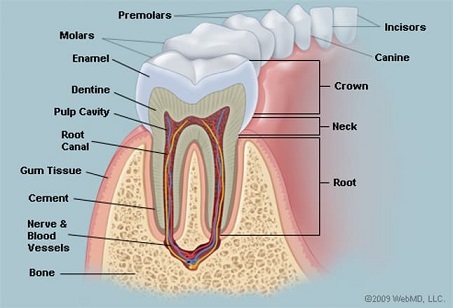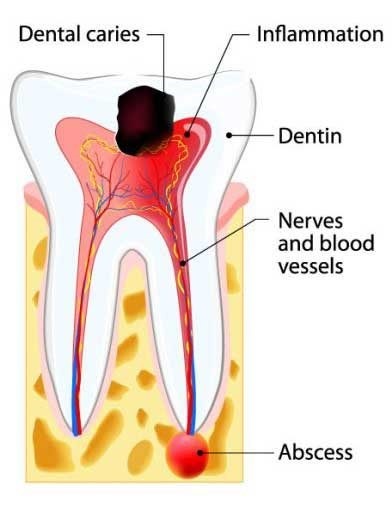What is a Root Canal Treatment?
Root canal treatment is a dental procedure used to eliminate bacteria from the infected root canal, avoiding reinfection of the tooth and save the natural tooth. When a tooth
undergoes a root canal treatment, the inflamed or infected pulp (The pulp is made up of nerves, connective tissue, and blood vessels that help the tooth grow) is removed and the inside of the tooth is carefully cleaned and disinfected, then filled and sealed.Root canal treatment is not painful in fact it can save a tooth otherwise have to be removed completely. In most cases, a general dentist or endodontist will perform a root canal while you’re under local anesthesia.
Saving the natural tooth with root canal treatment has many advantages:
· Efficient chewing
· Normal biting, force and sensation
· Natural appearance
· Protects other teeth from excessive wear or strain
Tooth Structure

A tooth is made up of 2 parts. The crown is the top part of the tooth that's visible in the mouth. The root extends into the bone of the jaw, anchoring the tooth in position. Besides being essential for chewing, the teeth play an important role in speech. A normal adult mouth has 32 teeth, which (except for wisdom teeth) have erupted by about age 13. Parts of the teeth include:
· enamel – the hard outer coating
· dentine – a softer material that supports the enamel and forms most of the tooth
· cementum – a hard material that coats the root's surface
· dental pulp – the soft tissue at the centre of the tooth
· Periodontal ligament: Tissue that helps hold the teeth tightly against the jaw.
The root canal system contains the dental pulp and extends from the crown of the tooth to the end of the root. A single tooth can have more than 1 root canal.
What will be done during root canal treatment?
Read more about this quick, easy procedure that can relieve your pain and save your natural tooth.



Inside your tooth, beneath the white enamel and a hard layer called dentin, is a soft tissue called pulp. This tissue contains blood vessels, nerves and connective tissue, which help grow the root of your tooth during its development. A fully developed tooth can survive without the pulp because the tooth continues to be nourished by the tissues surrounding it.
Before beginning your root canal, your healthcare provider will take dental X-rays of the affected tooth. This helps determine the extent of damage and ensures that root canal therapy is the appropriate treatment option. Here are the steps that will be completed during your root canal procedure:
1.Anesthesia. First, local anesthesia is given to numb the infected tooth and the surrounding gums. There are also medications used in dentistry to help you relax, such as nitrous oxide, oral sedatives or intravenous (IV) sedation. Your healthcare provider may recommend sedation if you struggle with dental anxiety.
2.Dental dam placement. Before beginning root canal treatment, a small rubber dam is placed over the area.
This isolates the tooth and keeps it dry during the procedure.
3.Hole inside the tooth. Next, a small opening is made in the crown of the tooth to access the pulp.
4.Removing Pulp. Tiny dental instruments are used to remove the nerves, blood vessels and tissues inside the tooth.
5.Shaping the canals. Once the pulp is removed, the pulp chamber and root canals are cleaned, disinfected and shaped.
6.Antibiotics: Once the pulp has been removed, the dentist may coat the area with a topical antibiotic to ensure that the infection is gone and to prevent reinfection. Once the canals are cleaned and disinfected, the dentist will fill and seal the tooth with a sealer paste and rubber-like material called gutta-percha. They also may prescribe you oral antibiotics. After a couple of days if you didn’t feel any pain, will come back to remove the antibiotics and replacing it with a temporary dental filling.
7.Filling the canals. The empty canals are then filled with a flexible, rubbery dental material called gutta-percha.
8.Sealing the tooth. Next, a temporary dental filling is placed to seal the tooth and prevent bacteria from re-entering.
9.Placing the final restoration. They’ll make sure that all infection is gone. They’ll also replace the temporary filling with a permanent filling. In some cases, you’ll need a dental crown (the part you can see above your gums) to protect the treated tooth and restore your bite. Crowns are custom-made, and fabrication usually takes two to three weeks. When your crown is ready, the temporary filling is removed and the permanent crown is placed. In some instances, you may be able to receive a crown during the same appointment.
Follow-up after your root canal treatment:
Your tooth and gums might feel sore when the numbing medication wears off. Your gums may also swell. Most dentists will have you treat these symptoms with over-the-counter pain medications such as acetaminophen (Tylenol) or ibuprofen (Advil). Call your dentist if the pain becomes extreme or lasts for more than a few days.
It's important to look after your teeth when recovering from root canal treatment. You should avoid biting on hard foods until your treatment is complete. In most cases it's possible to prevent the need for further root canal treatment by:
• keeping your teeth clean
• not eating too much sugary food
• giving up smoking if you smoke
Always try to take care of your teeth and gums
When is a root canal treatment needed?
Root canal treatment is needed when dental X-rays show that the pulp has been damaged by a bacterial infection. The pulp may become inflamed if it's infected by bacteria, allowing the bacteria to multiply and spread or when a deep cavity is left untreated for a long time. And you may need root canal treatment for a cracked tooth from injury or genetics, and issues from a previous filling. Patients generally need a root canal when they notice their teeth are sensitive, particularly to hot and cold sensations.
The most common symptoms that mean you may need root canal treatment:
• Severe pain while chewing or biting
• Pimples on the gums
• A chipped or cracked tooth or loose fillings
• broken crown
• Lingering sensitivity to hot or cold, even after the sensation has been removed
• Swollen or tender gums
• Deep decay or darkening of the gums
• Repeated dental treatment on the tooth
• An injury, such as a blow to your mouth
Is a root canal treatment painful?
Since patients are given anesthesia, a root canal isn’t more painful than a regular dental procedure, such as a filling or getting a wisdom tooth removed. However, a root canal is generally a bit sore or numb after the procedure, and can even cause mild discomfort for a few days. And many people are afraid they’ll have tooth pain after root canal therapy. However, because the source of infection is removed during the procedure, most people find immediate relief following treatment.
What are the alternatives to root canal treatment?
Root canal treatment is performed to save teeth, allowing you to keep a healthy, natural smile. The alternative to root canal treatment is to remove the tooth completely, as the infection won’t heal on its own. Your dentist will always try to save your natural tooth where they can, but they might recommend you should have the tooth removed if it’s badly damaged or if you have severe gum disease, which prevents your tooth from healing after treatment.
Risks of a root canal treatment
A root canal treatment is performed in an effort to save your tooth. Sometimes, however, the damage is too deep or the enamel is too frail to withstand the procedure. These factors can lead to loss of the tooth. Another risk is developing an abscess at the root of the tooth if some of the infected material remains behind or if the antibiotics aren’t effective.
If you’re apprehensive about a root canal treatment, you can talk to your dentist about an extraction instead. This often involves placing a partial denture, bridge, or implant in place of the damaged tooth. Failed root canal treatment symptoms include:
• Pain.
• Swollen gums.
• Pus or drainage.
• Tooth discoloration.
• Pimple or boil on the gums.
• Sinus problems.
How should I prepare for a root canal treatment?
Ask questions
Undergoing any procedure can cause anxiety and tension, particularly if you don’t know what to expect. Our team of dentists is always glad to answer any questions you may have.
Discuss antibiotics with your dentist
Infections can cause swelling and pain, which can make the root canal and recovery more uncomfortable. Antibiotics can also reduce your risk for developing an infection after your root canal. In some cases, our dentist may recommend taking antibiotics.
Avoid alcohol and tobacco for 24 hours before your procedure
The nicotine in tobacco products can change the way blood flows through your veins, which could lead to bleeding problems during and after your root canal. Smoking can also slow down your recovery time. Alcohol can dry out your mouth, affect how your blood clots, cause a fast heartbeat, and even depress your central nervous system.
Sleep well
Get a full night’s sleep before your appointment to ensure your body is in top form for your procedure. Since your body does most of its “repairs” while you sleep, plan to get another full night’s sleep after your root canal.
Take a pain reliever before your appointment
While today’s root canal procedure causes less discomfort than it used to, you can still expect a degree of soreness. Taking a pain reliever prior to root canal can help alleviate some of the discomfort you may experience during and immediately after your procedure. Be sure to consult with your dentist to determine the best analgesic to take – our dentist can help you decide whether to take acetaminophen or ibuprofen, depending on your personal needs.
Have a couple of doses of pain relievers on hand
You may benefit from taking acetaminophen or ibuprofen in the first few hours following your root canal. To avoid trips to the store immediately after your procedure, check to make sure you have a couple of doses of painkillers before you check in for your appointment.
Eat before your root canal treatment
Our dentist will administer anesthesia that numbs the tooth and surrounding tissue. This anesthesia takes several hours to wear off completely, and the numbness may make it difficult to eat. To avoid feeling hungry immediately after your root canal, eat a small meal a couple of hours before your root canal.
Arrange for a ride home, if necessary
Most people require only a local anesthetic to control discomfort from a root canal, and therefore do not need a ride home. Some patients need sedation medicine to relax or even general anesthesia before undergoing a root canal, though, and may benefit from having a driver. Speak with our dentist before your appointment to determine whether or not you will need a ride home after your root canal.
Stock up on the right food
Once your numbness has subsided, you can eat again. Focus on soft, cool foods and avoid hot, crunchy foods. Soft foods are easy to chew, or require no chewing at all. Cool foods can soothe irritated tissue and reduce any swelling you may have. Hot, crunch foods, by comparison, can irritate the treatment area to cause discomfort and slow healing.
Our dentists recommend that our patients eat the following foods immediately after a root canal procedure, while inflammation is still present:
• Smoothies
• Yogurt
• Soft cereal
• Milkshakes
• Pudding
After inflammation subsides, our team of dentists recommend eating some of the following foods:
• Fruits, such as bananas, pears, peaches, mangos, applesauce; continue to eat fruit smoothies
• Ice cream, free from nuts, crunchy bits or chunks
• Eggs
• Tofu
• Soup
• Humus
• Tuna salad
• Mashed vegetables, such as mashed potatoes or cauliflower
• Oatmeal, cream of wheat
• Pancakes
• Sushi
• Pasta, noodles
Be sure to stock up on these foods before your appointment of root canal treatment to spare yourself a trip to the store immediately after the procedure.
Avoid hot beverages, drinking from straws, or eating foods you have to suck, such as hard candy or lollipops, as they can trigger gum inflammation, cause discomfort, and slow healing.
Plan to take it easy for at least two days following your root canal
Resting gives your body time to heal. Avoid strenuous activity, such as working out or doing heavy lifting, for at least 48 hours after your root canal procedure. Exercising too soon after your root canal can lead to bleeding and even make your mouth feel achy. Our dentists can help you determine how long you should take it easy.
For more information about how you can prepare for a root canal, consult with our dental team at Basari Hospital - Dental Associates. We want to help you get the most out of your dental work.


